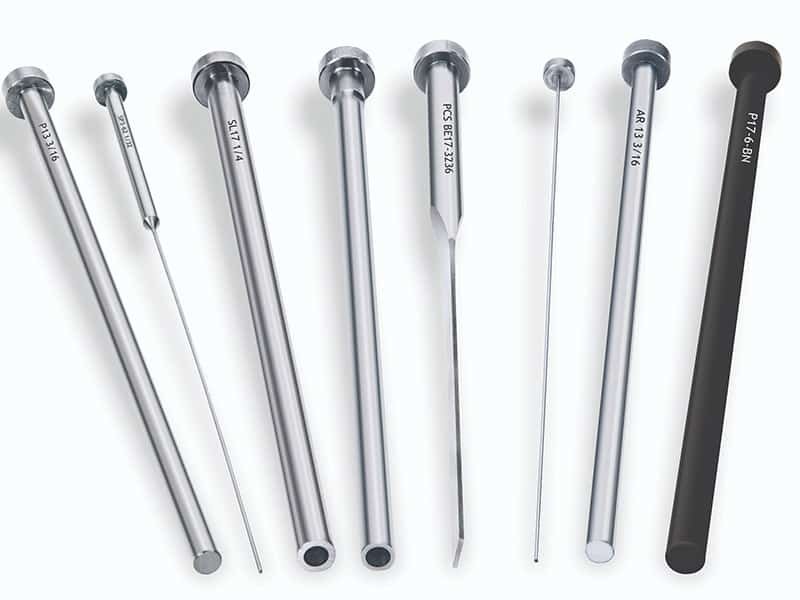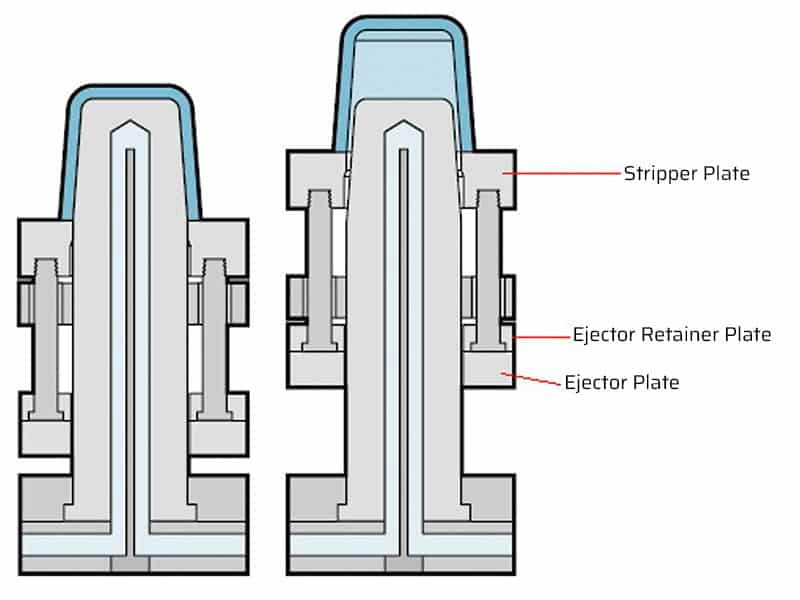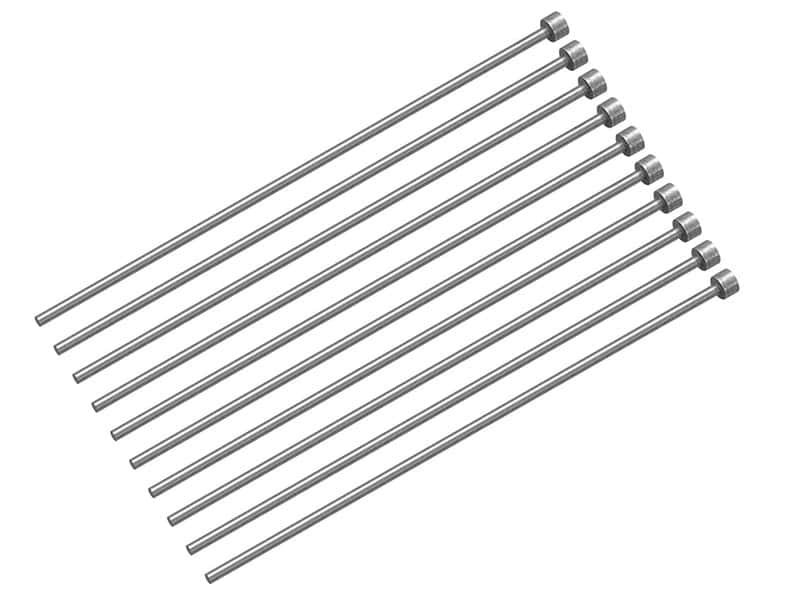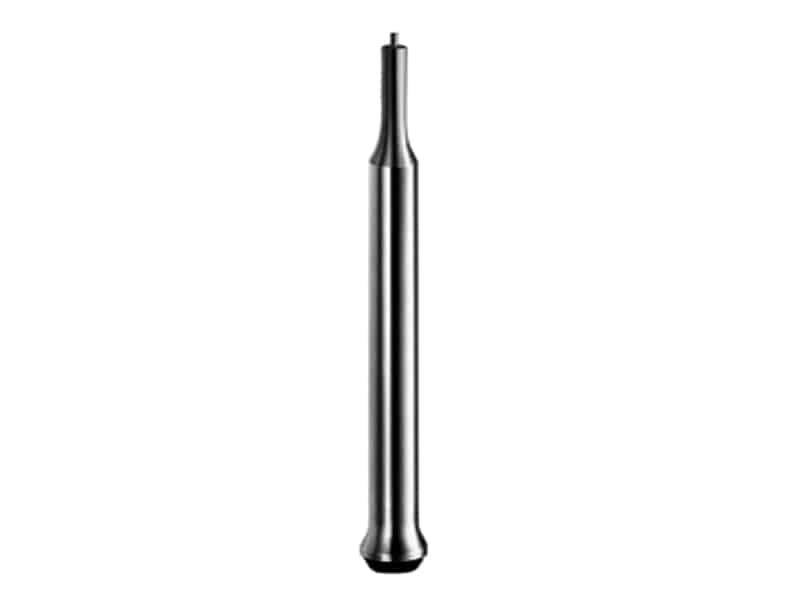Injection molding ejector pins are crucial for ensuring injection molded parts are efficiently and safely ejected from the mold cavity. With various ejector pin types available, each designed for specific molding challenges, selecting the right one is key to improving both production efficiency and part quality, understanding the diverse range of ejector pins and their applications is essential for achieving optimal results in high-volume manufacturing. This article explores the different ejector pin types, their functions, and best practices.
What Is Injection Molding Ejector Pin?
Ejector pins injection molding are essential components that ensure the successful and safe ejection of molded parts from the mold cavity. Positioned within the mold, these durable pins, often made of high-strength materials like stainless steel, apply force to push the cooled and solidified part out of the cavity. Their role is crucial in maintaining the integrity of the molded part, as improper ejection can lead to defects, such as part warping, flash, or ejection marks.
Ejector pins help facilitate a smooth, efficient, and precise ejection of the final part from the mold. Whether working with simple geometries or intricate designs, the role of mold ejector pins is indispensable in ensuring the quality and functionality of injection molded parts.
How Do Ejector Pins Work During the Injection Molding Cycle?
Injection molding ejector pins play a crucial role beyond simply ejecting the molded part; they are integral to the entire injection molding cycle. After the molten plastic is injected into the mold and cooled, the ejector pins are activated, applying pressure to push the part out of the cavity. This action requires precise control over speed, timing, and force to avoid part damage or improper ejection, which can lead to defects like ejector pin marks.
Additionally, the placement of these pins within the mold cavity directly impacts the efficiency of the process and the quality of the final product.
Ejector pins, typically mounted on the ejector plate, are driven by the molding machine’s ejector system. During the ejection phase, they transfer force to the solidified part, ensuring smooth removal without deformation. Fine-tuning the force and travel distance of these pins is essential to optimize the process for the specific mold and material used.
To get a deep understanding of how ejector pins work during the injection process, read the step-by-step guide to the injection molding process.
Key Components of the Ejector Pin System
The ejector pin system consists of several interconnected components, all of which contribute to its performance. These include the ejector pin itself, the ejector plate, and various support elements such as retainers and bushings. Each of these components has specific features and functions that ensure the efficiency and longevity of the injection molding process.
The Ejector Pin Itself

The ejector pin is the primary component in the ejector system. The pin must be durable enough to handle the pressures exerted during the ejection phase while maintaining its integrity over time. Common materials for ejector pins include stainless steel, which is chosen for its strength and resistance to corrosion, as well as carbide-coated pins, which offer enhanced wear resistance. The pin’s design can also vary, with features such as threaded tips for easier handling and custom modifications for specific applications. Depending on the part’s complexity and the molding material, ejector pins for molds may also have different finishes or coatings to prevent material buildup and enhance their lifespan.
Ejector Plates and Retainers

The ejector plate is a critical component that supports the ejector pins during the ejection process. It holds the pins in place and ensures they remain aligned and secure as they move during the cycle. The ejector plate is typically mounted on the machine’s ejector mechanism, and its movement drives the ejector pins forward to eject the part from the mold. Additionally, ejector pin retainers are used to secure the pins within the plate and prevent any misalignment or movement during operation.
Ejector Sleeves and Bushings
Ejector sleeves and bushings help to reduce friction between the ejector pin and the mold, ensuring smooth and consistent movement. The sleeves and bushings also help maintain the alignment of the ejector pins, preventing any wobble or misalignment during the ejection phase. Made from materials that offer low friction and high wear resistance, they contribute significantly to extending the lifespan of the ejector pins and the overall molding system. Ejector pin bushings are especially useful in high-volume production settings, where the continuous cycle puts substantial wear on the components.
The ejector pin system plays a vital role in the injection mold, read our blog Understanding Injection Mold Parts to get a full picture of all the mold components.
Ejector Pin Types
There are various ejector pin types used in injection molding, each designed for specific applications and part requirements. Selecting the appropriate ejector pin type is crucial to ensuring smooth, efficient, and high-quality ejection. The choice of pin type can affect both the molding cycle time and the final appearance of the part.
Straight Ejector Pins

Straight ejector pins are the most common and widely used type in injection molding. These pins are simple, straight shafts typically made of hardened steel or other durable materials. They are most often used in molds where the part is ejected along a single axis.
Tapered Ejector Pins

Tapered ejector pins have a conical shape that gradually reduces in diameter from one end to the other. These pins are often used when there is a need for more controlled part ejection, especially when the part needs to slide out of the mold cavity.
Blanked Ejector Pins
Blanked ejector pins are a type of pin with a flat, circular shape at one end. They are typically used in molds where the part being ejected is a disk, washer, or another flat shape. The flat surface ensures a uniform distribution of ejection force.
Stepped Ejector Pins

Stepped ejector pins feature multiple diameters along their length, creating steps or transitions between different sizes. These pins are used when the ejection force needs to be distributed differently across various parts of the mold.
Ejector Pins with Springs
Ejector pins with springs are used in situations where automatic or controlled retraction of the pin is required after part ejection. These pins feature a spring mechanism that pushes the pin back into its original position after it has been extended for ejection.
Heat-Treated Ejector Pins
Heat-treated ejector pins are made from materials that have undergone heat treatment processes to improve their hardness and durability. These pins are designed to withstand high pressures, temperatures, and wear during the injection molding process.
Guide Ejector Pins
Guide ejector pins are a hybrid design that incorporates features of both standard ejector pins and guide pins. These pins are used in molds where precise alignment of the ejector system is crucial, helping to ensure the proper movement of the ejector system during part ejection.
Pin-Type Ejector Systems
Pin-type ejector systems are specialized systems where multiple ejector pins are strategically placed to work together, often in high-cavity molds. These systems allow for more effective ejection across multiple parts simultaneously, making them ideal for mass production.
Floating Ejector Pins
Floating ejector pins are designed to move freely within a specific range of motion. These pins are often used in molds where there is some variation in part geometry, such as parts with undercuts or varying thicknesses.
Ejector Pin Design Considerations
Designing an effective ejector pin system is critical to achieving optimal results in the injection molding process. The ejector pin not only ensures the smooth removal of molded parts from the mold but also influences the overall quality and efficiency of the production cycle. Several factors must be taken into account when designing ejector pins, such as their size, shape, material, and placement within the mold. These considerations impact the performance of the ejector pin system and the quality of the final molded part.
Factors Influencing Ejector Pin Design: Size, Shape, and Material
The design of mould ejector pins is heavily influenced by the specific requirements of the injection molding project. One of the first factors to consider is the ejector pin size. The size of the pin must correspond to the dimensions of the molded part and the mold cavity. Too small of a pin may lead to inadequate force for ejection, while too large of a pin may cause damage to the part or the mold. The shape of the ejector pin is also an important consideration. Most pins have a cylindrical shape, but modifications may be required to address special features in the molded part, such as undercuts or intricate geometries. In some cases, custom ejector pin shapes are needed to align with specific mold designs or reduce wear on the mold.
Material selection is another key factor in the design of ejector pins for molds. Ejector pins need to withstand high pressure, temperature fluctuations, and frequent use without deforming or corroding. Stainless steel is a commonly used material due to its strength and corrosion resistance. For more demanding applications, carbide-coated pins or pins made from specialty alloys may be used to enhance wear resistance and longevity. The choice of material will depend on factors such as the molding material, the production volume, and the expected stresses during the ejection phase.
The Importance of Pin Placement in the Mold
Proper placement of ejector pins in injection molding influences both the ejection force and the potential for part damage. Ideally, injection mold ejector pins should be positioned at strategic points on the mold to apply uniform pressure during ejection. This helps to avoid uneven stress on the molded part, which can result in defects like warping or incomplete ejection. Careful planning of pin placement can also prevent issues such as excessive wear on specific areas of the mold or the part.
The distribution of ejector pins should consider the part’s geometry and size. For complex parts with varying thicknesses, multiple pins may be required at different locations to ensure uniform ejection. It’s also important to avoid placing ejector pins on aesthetically critical surfaces, as this may cause unwanted ejector pin marks.
Troubleshooting Ejector Pin Issues
Even with careful design and maintenance, ejector pins can face issues that affect the efficiency and quality of the injection molding process. Recognizing these problems early and knowing how to troubleshoot them is essential to minimizing downtime and ensuring that the final molded part meets the required standards. Below, we explore common ejector pin issues and how to address them effectively.
Diagnosing Ejector Pin Problems During Production
Diagnosing ejector pin problems during the production process requires a keen eye for detail and an understanding of the common issues that can arise. One of the first indicators of a problem is often visible ejector pin marks or inconsistent part ejection. If the parts are sticking to the mold or showing signs of damage, it may point to issues with pin alignment, pin size, or the overall functionality of the ejection system. Monitoring the molding cycle closely and conducting regular inspections will help identify problems early.
Key symptoms to look out for include:
- Uneven ejection: A part that is ejected at an angle or with difficulty often indicates improper placement or function of the ejector pins.
- Surface defects: Visible ejector pin marks or other surface imperfections on molded parts can be a result of pins being too large or positioned incorrectly.
- Increased cycle times: If the ejection process takes longer than usual, it may suggest issues with pin movement or the ejection force.
Regular checks and diagnostic tools, such as force sensors or visual inspections, can help pinpoint the exact cause of ejector pin malfunctions during production.
Fixing Misalignment and Improper Ejection with Ejector Pins
Misalignment of ejector pins can result in improper ejection, leading to part defects or even damage to the mold. Misalignment often occurs when the ejector pins are not properly secured or when the mold components shift during production. This issue can also arise from the accumulation of wear and tear over time, which affects the precision of pin movement.
To fix misalignment:
- Recalibrate the ejector system: Adjusting the alignment of the ejector pin system can help ensure that the pins move uniformly and apply consistent pressure during ejection.
- Check for wear and tear: Worn pins, sleeves, or bushings may cause the ejector pins to shift out of alignment. Replacing worn components can restore proper function.
- Lubricate the ejector pins: Proper lubrication reduces friction, ensuring smooth movement and preventing misalignment caused by metal-on-metal contact.
For more complex cases, a detailed inspection of the mold base and ejector components may be needed to identify any deformities or damage that could affect pin alignment.
Strategies for Handling Ejector Pin Breakage or Deformation
Ejector pins can break or become deformed due to excessive force, poor material selection, or improper use during the injection molding process. Breakage or deformation of the pins can significantly disrupt production and compromise the quality of the molded parts. Identifying the root cause of these issues is crucial for resolving them effectively.
Common causes of pin breakage include:
- Excessive ejection force: Applying too much pressure during ejection can cause the pin to break or bend.
- Material fatigue: Continuous exposure to high temperatures and stresses can lead to the degradation of the pin material, especially if the pin is not made of high-quality, wear-resistant material.
- Improper design: Pins that are too thin or incorrectly sized for the mold can be prone to breaking under pressure.
To prevent or handle ejector pin breakage:
- Use pins made of durable materials such as high-grade stainless steel or carbide to withstand higher pressures and temperatures.
- Adjust the molding parameters, including injection pressure and cooling rates, to reduce the likelihood of excessive force during ejection.
- Regularly inspect pins for signs of wear or damage, and replace them before they fail to avoid downtime.
In cases where deformation occurs, pins should be replaced immediately, and the root cause—whether design-related or process-related—should be addressed to prevent future issues.
When to Replace Ejector Pins?
Ejector pins are designed to withstand substantial stress, but over time, they inevitably wear out or become damaged. Knowing when to replace ejector pins is essential for maintaining mold performance and ensuring the quality of molded parts. Waiting too long to replace damaged or worn pins can result in production delays, mold damage, and poor part quality.
Indicators that it’s time to replace ejector pins include:
- Visible wear: If the pins show signs of scoring, corrosion, or pitting, it’s a clear indication that they need replacing.
- Frequent sticking: If ejector pins are becoming stuck or difficult to move, it could suggest internal damage or significant wear.
- Ejection failure: Parts that fail to eject properly, or which experience excessive resistance during ejection, may be the result of deteriorated pins.
- Excessive cycle time: When cycle times increase due to improper ejection, it could be due to pin degradation affecting the ejection force.
Regular maintenance, combined with visual inspections and measurements, will help identify when it’s time to replace the ejector pins in injection molding to maintain production efficiency.
The Role of Ejector Pins in Mold Design
The ejector pin system plays a crucial role in mold design, and its effectiveness can greatly impact the overall molding process. Integrating ejector pins into the design of the mold requires careful consideration of part geometry, material properties, and desired mold performance. A well-designed ejector pin system ensures that molded parts are ejected smoothly and without damage, contributing to higher production efficiency and part quality.
Integrating Ejector Pins into Mold Design for Optimal Performance
When designing an injection mold, mold ejector pins must be strategically integrated into the overall design to ensure smooth ejection and avoid potential part defects. The placement of pins should account for the size and complexity of the part being molded, as well as any potential undercuts, thin walls, or other challenging geometries. For optimal performance, the ejector pin system must be designed to:
- Apply even pressure during ejection, preventing part distortion or damage.
- Ensure uniform cooling, especially in complex mold designs with multiple cavities.
- Minimize friction between pins and mold components to reduce wear and extend the life of the ejector system.
Collaborating with experienced mold designers can help achieve a seamless integration of the ejector pin system, ensuring the mold performs at its best throughout the production cycle.
Best Practices for Pin Placement in Complex Mold Designs
In complex mold designs, precise ejector pin placement is crucial for ensuring the mold performs effectively. The placement of the pins must take into account the part’s geometry, potential undercuts, and the overall mold layout. Pin placement is particularly critical when dealing with multi-cavity molds, where uneven ejection or pin misalignment can cause defects across multiple parts.
Best practices for ejector pin placement in complex molds include:
- Pin symmetry: Ensure that the pins are symmetrically placed to apply even ejection pressure across the entire part.
- Strategic positioning: Avoid placing pins in areas that are critical to the part’s aesthetic appearance, as this can lead to visible ejector pin marks.
- Balance the number of pins: For parts with thicker sections or complex geometries, more pins may be needed to ensure uniform ejection.
Using advanced mold simulation software can also help in visualizing and optimizing the placement of ejector pins before actual production.
The Influence of Mold Cavity Design on Ejector Pin Functionality
The design of the mold cavity has a significant impact on the performance of the ejector pin system. Factors such as cavity size, shape, cooling channels, and venting all influence the efficiency of the ejection process. A well-designed cavity will ensure that the ejector pins can move freely and apply consistent force during ejection.
Key considerations include:
- Mold cavity shape: Complex mold cavities with intricate shapes or sharp corners may require specialized ejector pin types to navigate and eject the part without causing damage.
- Cooling channels: Properly placed cooling channels help ensure that the mold temperature is evenly distributed, which can prevent uneven shrinkage and improve ejection efficiency.
- Venting: Adequate venting reduces trapped air and gas in the cavity, allowing for smoother ejection of the part and reducing the risk of defects during the injection process.
Incorporating these considerations into the mold design ensures that the ejector pins function optimally, resulting in smooth and efficient production cycles.
Optimizing Ejector Pin Performance in Production
To achieve consistent, high-quality output in injection molding, it is essential to optimize the performance of ejector pins. Several factors influence how well the ejector pins perform during production, and small adjustments to these parameters can significantly improve part quality and reduce downtime. This section delves into the key adjustments and best practices for optimizing ejector pin systems in injection molding.
Adjusting Injection Speed and Pressure for Better Ejection
One of the critical factors in ejector pin performance is the injection speed and pressure. These two parameters directly affect the force applied during ejection and can influence whether parts are ejected smoothly or whether they get stuck in the mold. Too much injection pressure can lead to excessive stress on mold ejector pins, causing wear or breakage, while insufficient pressure may result in uneven or incomplete ejection.
To optimize ejector pin performance:
- Adjust injection speed: The speed at which the material is injected into the mold should be calibrated to ensure that the ejection force is consistent and does not damage the molded parts.
- Control injection pressure: Higher pressures may be necessary for denser materials, but it’s important to ensure that the pressure does not exceed the limits of the ejector pin or the mold design. A balance of speed and pressure ensures uniform ejection without causing excessive wear on the ejector pins.
- Monitor ejection force: The right balance of speed and pressure reduces the force required for ejection, which can extend the life of ejector pins for molds.
Regularly monitoring and adjusting these parameters during production can enhance the ejector pin system’sefficiency and longevity.
How Temperature Affects Ejector Pin Operation?
Temperature plays a crucial role in injection molding ejector pins, as the molds and pins themselves are subject to varying degrees of heat throughout the molding cycle. High temperatures can weaken the ejector pins or affect the material flow, leading to challenges in part ejection. On the other hand, mold temperatures that are too low can cause parts to shrink unevenly, increasing the friction between the ejector pin in injection molding and the part, which may result in sticking.
To optimize temperature control:
- Maintain uniform mold temperature: Consistent mold temperature is key to preventing issues with pin movement and part ejection. Using active temperature control systems can help keep the mold at a stable temperature, minimizing stress on the ejector pins.
- Manage cooling rates: The cooling rate should be optimized to allow for uniform shrinkage of the part. If the cooling rate is too fast or too slow, it can affect the ease of ejection and increase the likelihood of ejector pin marks on the part.
- Prevent overheating of pins: Ejector pins in injection moulding should be made from materials that can withstand high temperatures. Heat buildup in the ejector pin area can weaken its structure and lead to deformation.
By controlling temperature during the injection and cooling phases, manufacturers can reduce the risk of pin-related issues and improve the overall performance of the ejector system.
Fine-Tuning Mold and Pin Design for Consistency and Quality
Optimizing ejector pin performance is not only about adjusting production parameters—it’s also about ensuring that the mold and ejector pins are designed for maximum efficiency. Well-designed molds and pins contribute to consistent part ejection, reduced wear on components, and fewer production interruptions.
To fine-tune mold and ejector pin design:
- Design for uniform ejection: The mold should be designed to allow for uniform distribution of ejection force across the part. This minimizes the risk of damage to the injection molding ejector pins and ensures that the part is ejected cleanly without deformities or defects.
- Consider pin material: The material of the mold ejector pins must be chosen based on the temperature and pressure conditions of the injection molding process. High-quality materials such as hardened steel or stainless steel offer resistance to wear and provide durability in high-stress environments.
- Incorporate wear-resistant features: Designing the ejector pins with wear-resistant features, such as coatings or specialized materials, can significantly extend the life of the pins and reduce maintenance costs.
By continuously refining the design and functionality of the ejector pins and mold system, manufacturers can enhance production consistency, reduce downtime, and increase overall part quality.
Conclusion
The ejector pin system plays an integral role in the efficiency and quality of the injection molding process. By optimizing ejector pin performance, managing system components, and designing molds with ejector pins in mind, manufacturers can improve ejection consistency, reduce defects, and extend the life of their molding equipment. Whether managing ejector pins for multi-cavity molds, addressing common issues like ejector pin marks, or fine-tuning design for optimal performance, mastering ejector pin technology is key to ensuring high-quality, high-efficiency production.







